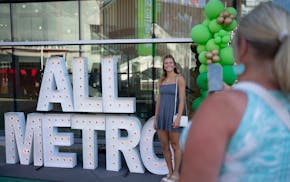Our group of eight stumbled upon the tastiest peach I have ever eaten, and one of the best cheeses. As we made Homer Simpson yummy sounds over our lunch at Bistro Maison, our waitress suggested that we check out the McMinnville farmers market. Where is it, we asked? "Just a few blocks that way," she said with a smile.
Heading west down 3rd Street, we heard, and even smelled, the market before we saw it, tucked into a side street and infused with the scent of bread and the sounds of a trio playing Parisian street music.
The market, held every Thursday during farm season in this impossibly quaint town, provided one of the signature memories of our four days in Oregon's Willamette Valley. It also served as a hallmark of great vacations: the melding of preconceived notions and best-laid plans with delightful surprises.
This wine-centric region half an hour southwest of Portland is pretty but rarely postcard-perfect, friendly but in an utterly unassuming manner and packed with destinations but mostly of the off-the-well-trod-path variety.
The effortless charm of Willamette (will-AM-ette) rewards but does not require a lot of prep work. We mapped out some wineries and restaurants but also stumbled upon the world's largest speed-limit signs and a meticulous restaurant matron whose sternness made her a doppelganger for "Young Frankenstein's" Frau Blücher.
Among our great expectations and swell surprises:
We expected the people and practices to be "green." From the stunning composite deck outside sustainable pioneer Sokol Blosser's tasting room to the outrageously tasty organic cheeses at the McMinnville farmers market, we encountered eco-friendly products and practices.
"Oregon brings that out in people," said Mimi Casteel, owner of Bethel Heights winery. "Most everyone came here and thought 'I don't want to screw this up.' So sustainability was important from the start." It shows.
We didn't expect the landscape to be so brown. Along the valley's highways, there are surprisingly few vineyards -- head to the hills for those -- but a boatload of hazelnut groves (Oregon grows 99 percent of the nation's crop). Beneath those tightly packed trees lies a very dusty surface, ideal for harvesting.
In August, most of the other farmland has a sepia tinge for a simple reason: Contrary to conventional wisdom, this is an extremely dry region for a third of the year, averaging less than 6 inches of rain from June through September.
We expected the dining to be diverse and delicious. We enjoyed tasty food at Dundee Bistro and Farm to Fork, but two other meals were particularly memorable. Every bite at the Painted Lady, from a beet terrine through roasted lamb and apple tart, was delicious, and the service was precise but infused with warmth.
A different kind of warmth enveloped us during the al fresco late lunch at Bistro Maison. Sun dappled through the trees and a boxer (of the canine ilk) dozed contentedly in the patio's corner as we languidly lapped up otherworldly bread, greens that seemed to have been picked seconds earlier and roasted local cheese. Utter bliss.
We didn't expect the drives to be so diverse. One day we headed to the Dundee Hills to visit a friend and could see for days to the south and all the way to Mount St. Helens 75 miles to the north. On another, a windy route through North Woods-type trees and terrain led to Elk Cove, its vineyards straight out of Tuscany. And no problem staying within the speed limit, since the signs bore numbers at least 2 feet tall (these might become more prevalent as baby boomers age).
But the highlight was a jaunt along the Ribbon Ridge region's gravel roads to a winery that lived up to its name: Brick House. In the semi-refurbished barn behind the eponymous farmhouse, we sipped glorious, rustic pinot noirs with owner Doug Tunnell, a former CBS News correspondent. The surrounding vineyards and complete silence were straight out of a movie set.
We expected the wines to rival Napa's best. Along with Brick House, we tasted superb pinot noirs, mostly from the stupendous 2008 vintage (probably Oregon's best ever), at Ken Wright, Cristom, Bergstrom and Domaine Serene. Along with Antica Terra, Ponzi and Evening Land enjoyed during meals, these pinots rivaled Napa's signature cabernets in quality.
That was no big surprise -- the Willamette Valley produces 97 percent of Oregon's pinot noir on 1 percent of its land -- but the white wines were a revelation. Bethel Heights' gewürztraminer, Penner-Ash's viognier and Sokol Blosser's pinot blanc were stunning. Side note: The Ken Wright tasting room in Carlton is the only place in the world to try or buy the Wisconsin native's incredible pinot blanc.
We didn't expect the wineries to resemble Napa's biggest. Brick House is a bit of an outlier with its down-home setting. From Sokol Blosser's fits-right-in-the-landscape (and the 21st century) cave and tasting room to Penner-Ash's mountain lodge, many wineries and estates would fit seamlessly in Northern California's wine country. One of the most gorgeous: the Mediterranean villa at Domaine Serene, owned by Twin Citians Ken and Grace Evenstad.
We also encountered a couple of Napa staples in tasting rooms: a boisterous bridal party at Elk Cove and a soapbox-wielding libertarian dude at Penner-Ash. Somehow, it wouldn't have seemed like Wine Country without them.
One final surprise: We expect to go back, very soon.
Bill Ward • 612-673-7643

What to know about the latest COVID variants, Minnesota testing, vaccines
Sign up for Star Tribune newsletters

126 birds on list 'lost to science'

